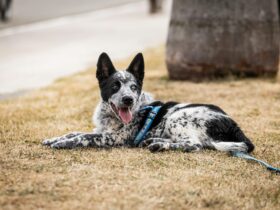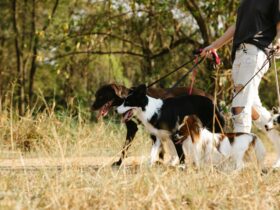Introduction
Dog agility training is not just about teaching your dog to jump through hoops or navigate through tunnels; it’s a comprehensive activity that enhances your dog’s physical and mental well-being. Whether you’re a seasoned dog owner or a newcomer, agility training offers a unique way to bond with your dog while improving their health and happiness.
In this blog, we’ll explore the many benefits of dog agility training, from enhancing physical fitness to boosting confidence. We’ll also provide you with practical steps to get started on this exciting journey.
The Benefits of Dog Agility Training
1. Improved Physical Health
Agility training is a fantastic way to keep your dog physically fit. The courses involve a variety of obstacles, including jumps, tunnels, and weave poles, that require your dog to use different muscle groups. This physical exercise helps in:
- Weight Management: Regular agility training helps prevent obesity in dogs by keeping them active and burning calories.
- Increased Stamina: The diverse exercises in agility training improve your dog’s cardiovascular health and stamina.
- Enhanced Coordination: Navigating through complex courses enhances your dog’s coordination and motor skills.
2. Mental Stimulation
Agility training is not just a physical challenge; it’s also a mental workout for your dog. Each obstacle requires your dog to think, make quick decisions, and respond to your cues. This mental stimulation can:
- Prevent Boredom: Engaging your dog’s mind helps prevent behavioral problems that can arise from boredom.
- Enhance Problem-Solving Skills: The variety of obstacles teaches your dog to think critically and solve problems on the go.
- Strengthen Focus: Agility training sharpens your dog’s ability to focus on tasks and follow instructions.
3. Stronger Bond with Your Dog
Agility training is a team sport. It requires you and your dog to work together, which can significantly strengthen the bond between you. Benefits include:
- Improved Communication: The training improves your ability to communicate with your dog through verbal cues and body language.
- Trust Building: Successfully navigating courses together fosters trust between you and your dog.
- Mutual Enjoyment: The shared experience of overcoming challenges creates a sense of accomplishment and joy for both of you.
4. Increased Confidence in Your Dog
Successfully completing agility courses can boost your dog’s confidence. This newfound confidence can translate into other areas of life, such as:
- Social Situations: A confident dog is more likely to interact positively with other dogs and people.
- Adaptability: Your dog becomes more adaptable to new environments and challenges.
- Reduced Anxiety: The sense of accomplishment from agility training can reduce anxiety and fear in your dog.
5. Socialization Opportunities
Agility training often takes place in group settings, providing your dog with the chance to socialize with other dogs. This socialization is crucial for:
- Developing Social Skills: Regular interaction with other dogs helps your dog develop healthy social behaviors.
- Reducing Aggression: Socialized dogs are less likely to exhibit aggressive behavior towards other dogs.
- Building Friendships: Both you and your dog can make new friends through agility classes and events.
How to Get Started with Dog Agility Training
1. Assess Your Dog’s Readiness
Before starting agility training, it’s essential to assess whether your dog is physically and mentally ready. Consider the following:
- Health Check: Ensure your dog is in good health. A visit to the vet can help you determine if your dog is ready for agility training.
- Basic Obedience Training: Your dog should have a good grasp of basic commands like sit, stay, and come. This foundation is crucial for successful agility training.
- Energy Levels: High-energy dogs often excel in agility training, but it’s suitable for many breeds as long as the training is adjusted to their capabilities.
2. Find the Right Equipment
Agility training requires specific equipment to create the course. You can start with the basics:
- Jumps: These can be simple hurdles that your dog jumps over.
- Tunnels: A flexible tunnel that your dog can run through is a staple in agility courses.
- Weave Poles: Poles that your dog must weave through provide an excellent challenge.
- A-Frame: A slanted frame that your dog climbs up and down adds variety to the course.
You can purchase this equipment or, if you’re on a budget, create DIY versions at home.
3. Start with Basic Training
Begin with simple obstacles and gradually increase the complexity as your dog becomes more comfortable. Here’s a basic approach:
- Introduce One Obstacle at a Time: Allow your dog to get used to each piece of equipment before combining them into a course.
- Use Positive Reinforcement: Reward your dog with treats and praise when they successfully navigate an obstacle.
- Keep Sessions Short: Agility training should be fun, so keep sessions short to prevent burnout and maintain your dog’s interest.
4. Join an Agility Training Class
If you’re serious about agility training, consider joining a local class. These classes offer:
- Professional Guidance: Experienced trainers can provide valuable tips and ensure that you and your dog are progressing correctly.
- Structured Environment: Classes offer a structured environment that mimics actual competitions.
- Social Interaction: Training in a group setting gives your dog the chance to interact with other dogs.
5. Practice Regularly
Consistency is key in agility training. Regular practice helps your dog improve and maintain their skills. Tips for regular practice include:
- Set Up a Home Course: Even if it’s just a few obstacles, practicing at home can make a big difference.
- Vary the Routine: Change the order of obstacles and introduce new ones to keep the training exciting.
- Track Progress: Keep a log of your dog’s progress to identify areas that need improvement and celebrate successes.
6. Participate in Competitions
Once your dog is comfortable with agility training, you might consider participating in competitions. Benefits of competing include:
- Challenging Your Dog: Competitions provide new challenges and help your dog reach their full potential.
- Meeting Like-Minded Owners: Competitions are a great way to meet other dog owners who share your passion for agility training.
- Showcasing Skills: It’s an opportunity to show off the skills you and your dog have worked hard to develop.
Conclusion
Dog agility training is a rewarding activity that offers numerous benefits for both you and your dog. From improving physical health to strengthening your bond, agility training is a holistic approach to your dog’s well-being. Whether you’re starting with basic obstacles at home or joining a professional class, the journey is sure to be fun and fulfilling.
With the right preparation and consistent practice, agility training can become a favorite pastime for you and your furry friend. So, why not get started today and experience the joys of dog agility training?











Leave a Reply